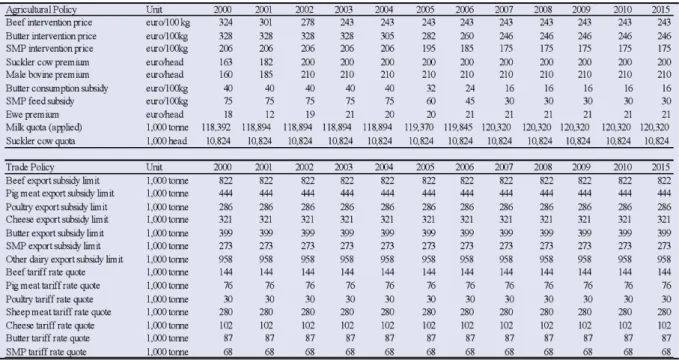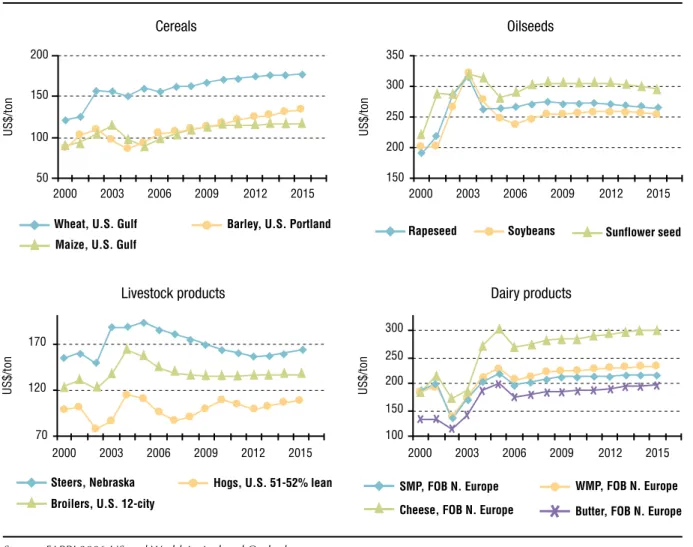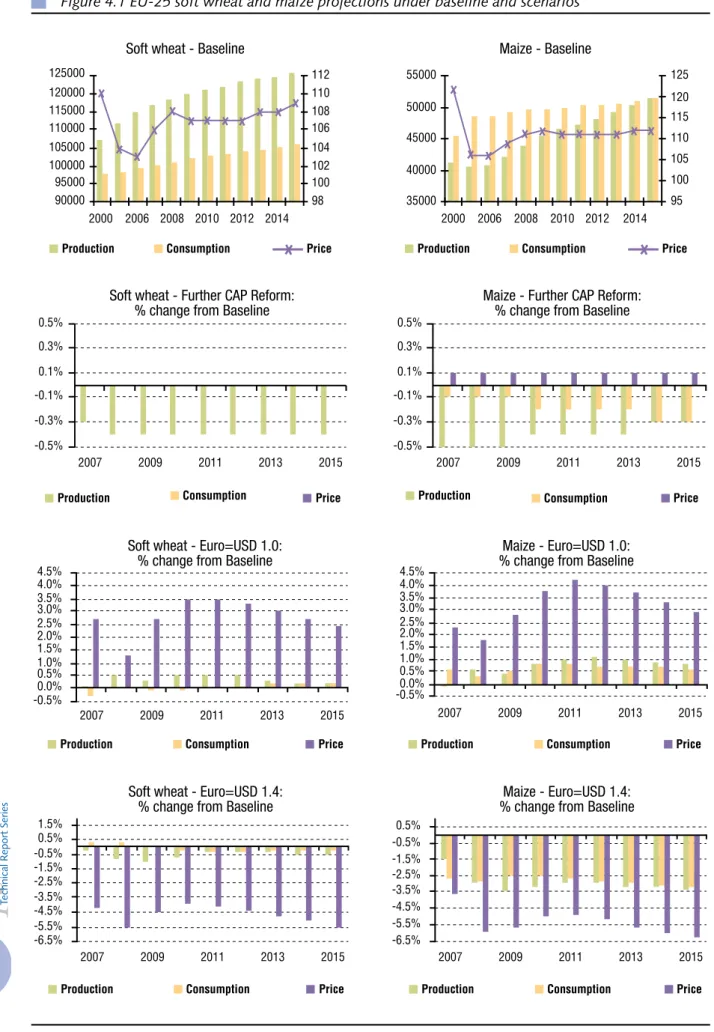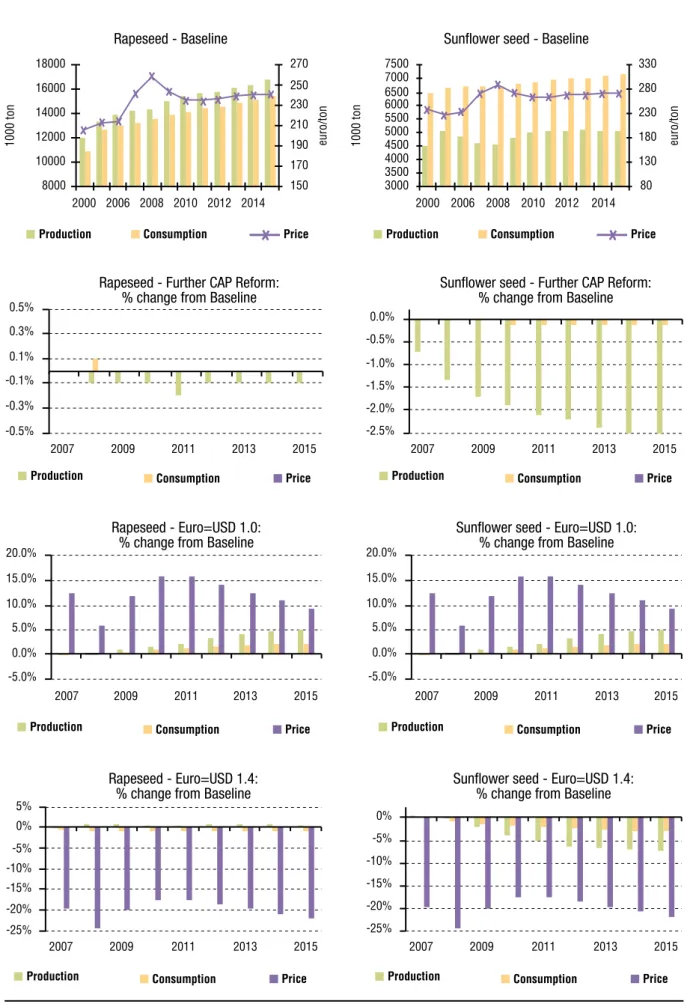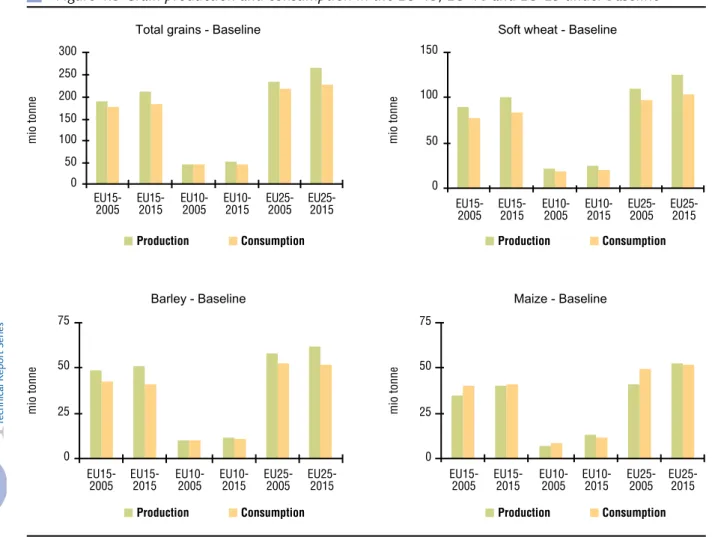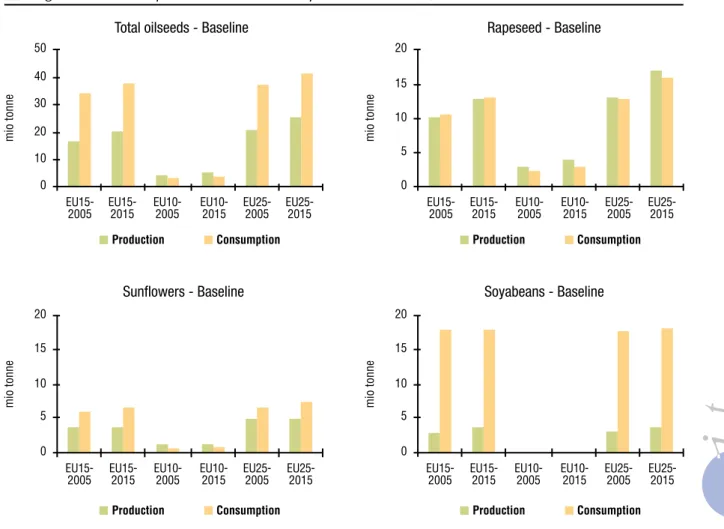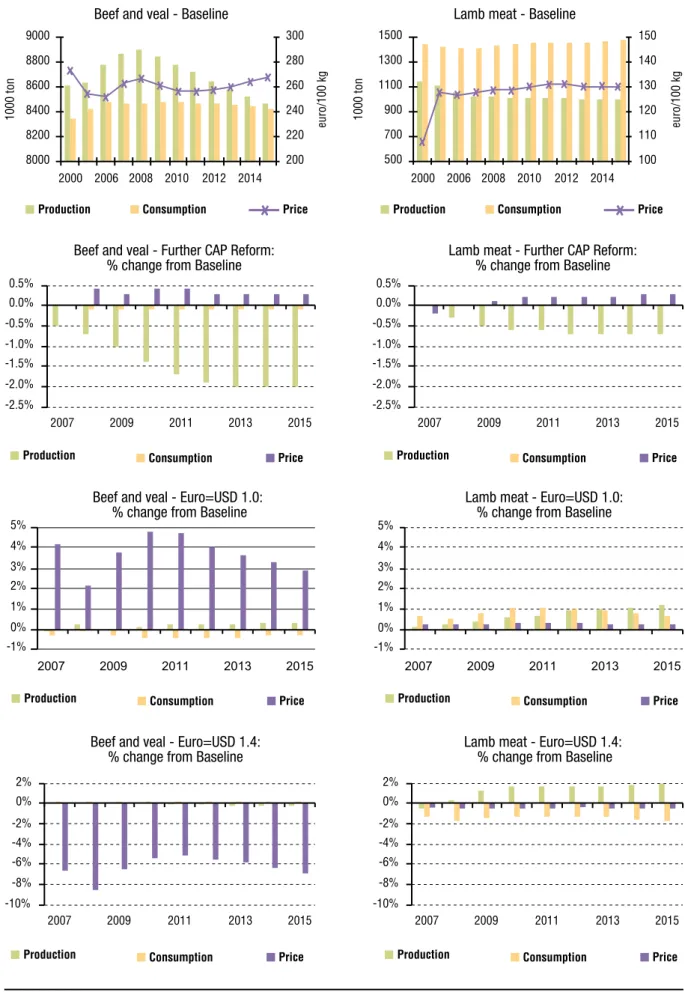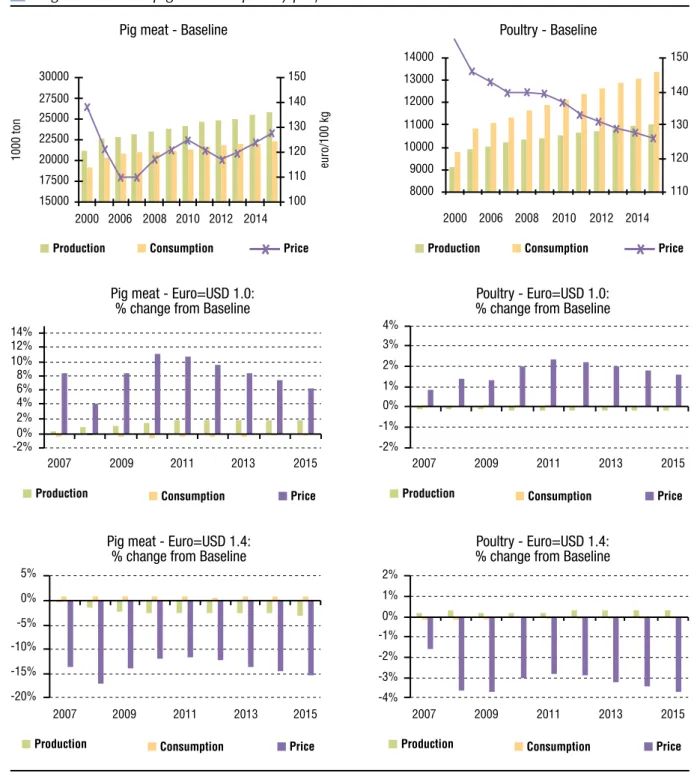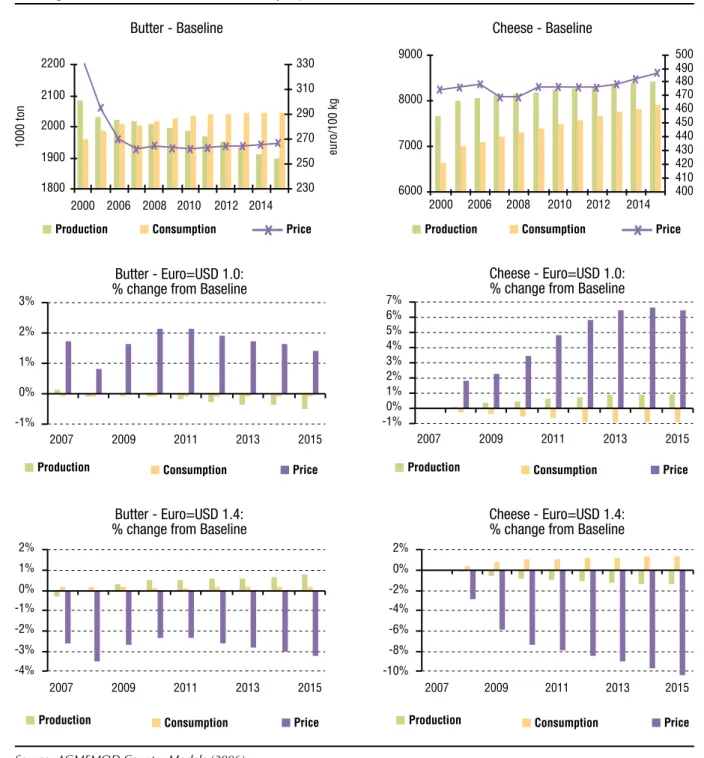HAL Id: hal-01462422
https://hal.archives-ouvertes.fr/hal-01462422
Submitted on 6 Jun 2020HAL is a multi-disciplinary open access
archive for the deposit and dissemination of sci-entific research documents, whether they are pub-lished or not. The documents may come from teaching and research institutions in France or abroad, or from public or private research centers.
L’archive ouverte pluridisciplinaire HAL, est destinée au dépôt et à la diffusion de documents scientifiques de niveau recherche, publiés ou non, émanant des établissements d’enseignement et de recherche français ou étrangers, des laboratoires publics ou privés.
Impact analysis of the CAP reform on main agricultural
commodities. Report I AGMEMOD – Summary report
Lubica Bartova, Robert M’Barek, Hans van Meijl, Myrna van Leeuwen,
Andrzej Tabeau, Petra Salamon, Oliver von Ledebur, Frederic Chantreuil,
Fabrice Levert, Trevor Donnellan, et al.
To cite this version:
Lubica Bartova, Robert M’Barek, Hans van Meijl, Myrna van Leeuwen, Andrzej Tabeau, et al.. Impact analysis of the CAP reform on main agricultural commodities. Report I AGMEMOD – Summary report. [Contract] EUR 22940 EN/1, European Commission. 2008, 74 p. �hal-01462422�
Impact Analysis of CAP Reform on the
Main Agricultural Commodities
Report I
AGMEMOD – Summary Report
Authors: AGMEMOD Partnership
Editors: Lubica Bartova and Robert M’barek
Impact Analysis
of CAP Reform
on the Main
Agricultural
Commodities
Report I
AGMEMOD - Summary Report
Authors:
AGMEMOD Partnership
Editors:
Lubica Bartova, Robert M’barek
2008
The mission of the IPTS is to provide customer-driven support to the EU policy-making process by researching science-based responses to policy challenges that have both a socio-economic and a scientific or technological dimension.
European Commission
Joint Research Centre Institute for Prospective Technological Studies
Contact information Address: Edificio Expo. c/ Inca Garcilaso, s/n. E-41092
Seville (Spain) E-mail: jrc-ipts-secretariat@ec.europa.eu Tel.: +34 954488318 Fax: +34 954488300 http://ipts.jrc.ec.europa.eu http://www.jrc.ec.europa.eu Legal Notice
Neither the European Commission nor any person acting on behalf of the Commission is responsible for the use which might be made of this publication. A great deal of additional information on the European
Union is available on the Internet. It can be accessed through the Europa server http://europa.eu/ JRC38071 EUR 22940 EN/1 ISBN 978-92-79-07623-7 ISSN 1018-5593 DOI 10.2791/59386
Luxembourg: Office for Official Publications of the European Communities
© European Communities, 2008
Reproduction is authorised provided the source is acknowledged Printed in Spain
Impact Analysis of CAP Reform on the Main Agricultural Commodities
3
AGMEMOD Partnership:
• Agricultural Economics Research Institute (LEI), The Hague, The Netherlands: Hans van
Meijl, Myrna van Leeuwen, Andrzej Tabeau • Bundesforschungsanstalt für Landwirtschaft
(FAL), Braunschweig, Germany: Petra
Salamon, Oliver von Ledebur
• Centre of Agricultural Economics, INRA-ESR, Rennes, France: Frédéric Chantreuil, Fabrice
Levert
• Teagasc-Rural Economy Research Centre (RERC), Athenry, Co. Galway, Ireland: Trevor
Donnellan, Kevin Hanrahan
• Latvian State Institute of Agrarian Economics (LSIAE), Riga, Latvia: Danute Jasjko, Guna
Salputra, Ludmilla Fadejeva
• University of Ljubljana, Biotechnical Faculty (LJUB), Ljubljana, Slovenia: Emil Erjavec,
Stane Kavcic, Darja Regoršek
• Universitat fur Bodenkultur Wien (BOKU), Wien, Austria: Martin Kniepert
• Université Catholique de Louvain (UCL), Louvain-La-Neuve, Belgium: Bruno Henry de
Frahan, Olivier Harmignie
• Institute of Agriculture Economics (IEABG), Sofia, Bulgaria: Nedka Ivanova, Mariya
Peneva
• Research Institute of Agriculture Economics (VUZE), Prague, Czech Republic: Ivan Foltyn,
Jan Kubát
• Food and Resource Economic Institute (FØI), Frederiksberg C, Denmark: Jorgen Dejgaard
Jensen
• Institute of Economics and Social Sciences of Estonian Agricultural University (EAU), Tartu, Estonia: Mati Sepp
• MTT Agrifood Research Finland (MTT), Helsinki, Finland: Jyrki Niemi, Lauri
Kettunen
• Department of Economics, University of Athens (NKUA), Athens, Greece: Elias Mantzouneas
• Corvinus University of Budapest (CUB), Budapest, Hungary: Tibor Ferenczi
• Polytechnic University of Marche-Ancona (UNIVPM), Ancona, Italy: Roberto Esposti,
Antonello Lobianco
• Lithuanian Institute of Agrarian Economics (LAEI), Vilnius, Lithuania: Irena
Krisciukaitiene, Salomeja Andrekiene, Andrej Jedik, Willi Meyers, Aiste Galnaityte
• Warsaw School of Economics (WSE), Warsaw, Poland: Sylwia Krawczyńska, Katarzyna Kowalska
• Institute of Agricultural Economics (IEARO), Bucharest, Romania: Camelia Serbanescu,
Cristian Kevorchian
• Slovak Agricultural University (SAU), Nitra, Slovak Republic: Lubica Bartova, Pavel
Ciaian, Jan Pokrivcak
• Unidad de Economia Agraria, Centro de Investigacion y Tecnologia Agroalimentaria de Aragon, (CITA), Zaragoza, Spain: Azucena
Gracia
• Queen’s University of Belfast (QUB), Belfast, UK: Zi Ping Wu, Philip Kostov
5
Impact Analysis of CAP Reform on the Main Agricultural Commodities
Quantitative models are important tools for analysing the impact of agricultural policies. One of the modelling approaches used to analyse the impact of the Common Agricultural Policy is AGMEMOD (AGricultural MEmber states MODelling), an econometric, dynamic, partial equilibrium, multi-country, multi-market model. AGMEMOD models provide extensive details of the agricultural sector in individual EU Member States including the new members Bulgaria and Romania, and the EU as a whole.
A study was carried out from November 2005 until June 2007 by the AGMEMOD Partnership under the management of the Agricultural Economics Research Institute (LEI, the Netherlands), in cooperation with the European Commission’s Joint Research Centre - Institute for Prospective Technological Studies (JRC-IPTS). The aim was to generate projections for the main agricultural commodity markets for each year from 2005 until 2015.
Detailed documentation on the AGMEMOD modelling approach, along with the outcome of the study, is published in five reports in the JRC-IPTS Scientific and Technical Report Series (Box 1) under the heading “Impact analysis of CAP reform on the main agricultural commodities”.
Box 1 Impact analysis of CAP reform on the main agricultural commodities
Report I AGMEMOD – Summary Report
This report presents the projections of agricultural commodity markets under the baseline, further CAP reform, enlargement scenarios and exchange rate change sensitivity analyses for the aggregates EU-10, EU-15, EU-25 and EU-27. It summarises the characteristics of the modelling tool used, focusing in particular on the features implemented in this study, and addresses issues that need further attention. (http://www.jrc.es/publications)
Report II AGMEMOD – Member States Results
This report outlines the results of the baseline projections of agricultural commodity markets, further CAP reform scenario impact analyses and exchange rate change sensitivity analyses for individual EU-27 Member States except Malta and Cyprus. For Bulgaria and Romania enlargement and non-enlargement scenarios are analysed. (http:// www.jrc.es/publications)
Report III AGMEMOD – Model Description
This report describes the modelling techniques used by the AGMEMOD Partnership, with the emphasis on new commodities modelled and policy modelling approaches. (http://www.jrc.es/publications)
Report IV AGMEMOD – GSE Interface Manual
The Manual gives an overview of the GAMS Simulation Environment (GSE) interface and its application with the AGMEMOD model. (http://www.jrc.es/publications)
Report V Commodity Modelling in an Enlarged Europe – November 2006 Workshop Proceedings
These proceedings consist of presentations and conclusions of a workshop held in November 2006. The presentation of outcomes of the other models such as FAPRI, ESIM, AGLINK and CAPSIM are included in addition to the AGMEMOD approach. (http://www.jrc.es/publications)
We acknowledge the work undertaken by country teams of the AGMEMOD Partnership and by Myrna van Leeuwen, LEI, the Netherlands, the project co-ordinator.
7
Impact Analysis of CAP Reform on the Main Agricultural Commodities
Executive Summary
This report presents the main outcome of the study “Impact Analysis of CAP Reform on the Main Agricultural Commodities” providing projections for each year from 2005 until 2015 for individual Member States, for the aggregates EU-10, EU-15, EU-25 and EU-27. The study was carried out by the AGMEMOD Partnership under the management of the Agricultural Economics Research Institute (LEI, the Netherlands), in cooperation with the European Commission’s Joint Research Centre - Institute for Prospective Technological Studies (JRC-IPTS).
AGMEMOD is an econometric, dynamic, partial equilibrium, multi-country, multi-market model. The AGMEMOD models provide extensive details of the agricultural sector in individual EU Member States and the EU as a whole.
The objectives of the study were threefold:
i) To provide market projections for the main European agricultural commodities based on the latest agricultural and trade policy developments and information available;
ii) To assess the impacts of selected scenarios on the main European agricultural commodity markets. In particular, these scenarios concern the introduction of decoupling and new direct payment schemes as well as the enlargement of the EU in 2007;
iii) To apply and improve an agricultural sector model for the enlarged EU, implemented in standard computer software (GAMS and MS Excel), and to make a preliminary version operational and available for the European Commission.
Projections and simulations have been generated for individual EU Member States and the EU at
different aggregation levels (EU-10, EU-15, EU-25, EU-27), providing results on supply, demand, trade and prices for the main agricultural commodities (cereals, oilseeds, livestock products and dairy products).
Impact of the following scenarios was analysed:
• The Baseline scenario for the EU-15 and Slovenia reflects the 2003 CAP reform, which covers the additional milk quotas, a cut in intervention prices and national implementation of the Single Farm Payment Scheme. For the EU-10 implementation of the Single Area Payment Scheme until 2008 followed by introduction of the Single Farm Payment Scheme from 2009 onwards are assumed. Complementary national direct payments remain in force in the EU-10 until 2013; • The Further CAP Reform scenario, in which all direct payments are decoupled and the rates of
compulsory modulation are doubled to 10%, both from 2007 onwards;
• The Enlargement scenario, which examines the consequences of accession to the EU of Bulgaria and Romania.
The AGMEMOD modelling system applied in this study has been econometrically estimated at individual Member State level. The country models contain the behavioural responses of economic agents to changes in prices, policy instruments and other exogenous variables of agricultural markets. Commodity prices adjust so as to clear all markets considered. For each commodity modelled in each country and each aggregate, the system generates the main domestic market variables such as production, food and feed demand, prices, trade and stocks. Agricultural income is calculated at sector level. As all policy-relevant
8
Executive Summary
agricultural markets are covered, the econometrically modelled country-specific agricultural markets also provide a sound basis for an analysis of the impacts of policy changes.
To ensure that the projections of the modelling system are consistent from an economic and policy perspective, projections have been validated by standard econometric methods and through consultation with national experts. In addition, the study analysed the impact of three alternative paths of US dollar versus euro exchange rate changes in a form of a sensitivity analysis. The obtained projections largely accord with the a priori expectations. A decline (increase) in the value of the €/US dollar exchange rate compared with the baseline assumptions leads to higher (lower) internal EU market prices and consequent adjustments to production, domestic use, imports and exports.
Although results differ across countries and the aggregates (EU-15, EU-10), the key findings of this
study regarding the aggregated EU-25 baseline projection analyses are as follows:
• Despite the decoupling measures of the 2003 CAP reform (also referred to as the Luxembourg Agreement), the EU production in several sectors (wheat, maize) will grow over the period 2005-2015.
• Higher dynamics can be found in the oilseed sector with demand propelling the markets. • The decoupled payments will induce a further decline in beef and lamb production. • Pig meat and poultry production are largely unaffected by decoupling.
• The EU dairy production is expected to decline as a consequence of the reductions in intervention prices for dairy products, but milk quotas will be fulfilled.
• Butter and skimmed milk powder production will decrease and at the same time growth in the production of cheese is projected.
The key findings of this study regarding the scenario projection analyses are as follows:
• The Further CAP Reform scenario projections tie in with a priori expectations, in that the impact of policy measures assumed in this scenario is very limited due to the fact that many Member States had already chosen to largely decouple direct payments under their implementation of the Luxembourg Agreement at national level.
• The 2007 Enlargement of the EU with the accession of Romania and Bulgaria is not expected to dramatically change the situation of most key EU agricultural markets. There are increases projected for the production of EU sunflower oil, soft wheat and maize, but accession is projected to have less of an impact on livestock and meat markets.
Although the agricultural markets of the individual countries have differing levels of development and the country models are being further developed, the projections provide useful information about general trends on the EU’s main agricultural markets.
Impact Analysis of CAP Reform on the Main Agricultural Commodities
9
Foreword
5
Executive Summary
7
Acronyms
13
1. Introduction
15
2. Model description / methodological approach
17
3. Baseline and Scenario Results
21
3.1. Descriptions of scenarios and assumptions
21
3.2. Baseline
21
3.2.1. Agricultural policy
21
3.2.2. Trade policy
22
3.2.3. Macro-economy
22
3.2.4. World market prices
23
3.3. Scenarios
24
3.3.1. Further CAP Reform scenario
25
3.3.2. EU Enlargement scenario
25
3.3.3. Exchange Rate Change scenario (sensitivity analysis)
27
4. EU-25 baseline and scenarios projections
29
4.1. Crops
29
4.1.1. EU-25 - grains and oilseeds
29
4.1.2. EU-15 and EU-10 - grains and oilseeds
32
4.2. Livestock and dairy products
34
4.2.1. EU-25 - livestock products
34
4.2.2. EU-25 - dairy products
37
4.2.3. EU-15 and EU-10 - livestock products
37
4.2.4. EU-15 and EU-10 - dairy products
40
4.3. Agricultural income
42
4.3.1. EU-25 – gross income
42
4.3.2. EU-15 and EU-10 – gross income
43
10
Table of contents
5. EU-27 baseline and scenarios projections
45
5.1. Crops
45
5.1.1. Bulgaria and Romania – grains and oilseeds
45
5.1.2. EU-27 – grains and oilseeds
46
5.2. Livestock and dairy products
47
5.2.1. Bulgaria and Romania – livestock products and milk
47
5.2.2. EU-27 – livestock products and milk
49
5.3. Agricultural income
50
5.3.1. Bulgaria and Romania – gross income
50
5.3.2. EU-27 – gross income
51
6. Discussion and Conclusions
53
8. References
55
9. Appendix 1 Baseline projections and scenario impacts in EU-15 and EU-10
57
List of Tables
Table 3.1 Crop-related policy instruments used in AGMEMOD
23
Table 3.2 Livestock and livestock product-related policy instruments used in
AGMEMOD
23
Table 3.3 Summary of scenarios to be analysed
26
Table 4.1 Self-sufficiency rates for grains in the EU-15, EU-10 and EU-25
under baseline
33
Table 4.2 Self-sufficiency rates for oilseeds in the EU-15, EU-10 and EU-25
under baseline
34
Table 4.3 Self-sufficiency rates for livestock products in the EU-15, EU-10 and
EU-25 under baseline
40
Table 4.4 Self-sufficiency rates for dairy products in the EU-15, EU-10 and
EU-25 under baseline
41
Table 4.5 EU-25 output value, subsidies, feed costs and gross income in baseline
42
Table 4.6 EU-25 output value, subsidies, feed costs and gross income in
Further CAP Reform scenario (% change from baseline)
42
Table 4.7 Agricultural output value, subsidies, feeding costs and agricultural
income in the EU-15, EU-10 and EU-25 under baseline (2000=1)
43
Table 5.1 Increase in EU-27 crop production (% change from EU-25 production)
46
Table 5.2 Self-sufficiency rates for crops in the EU-25 compared to the EU-27
in 2015
47
Table 5.4 Self-sufficiency rates for livestock products in the EU-25 compared
to the EU-27 in 2015
49
Table 5.3 Increase in EU-27 livestock production (% change from EU-25
production)
49
Table 5.5 Agricultural output value, subsidies and agricultural income in the
Impact Analysis of CAP Reform on the Main Agricultural Commodities
11
List of Figures
Figure 2.1 File structure of EU-15 combined model
17
Figure 2.2 EU-25 hybrid model structure of AGMEMOD
18
Figure 2.3 EU-27 hybrid model structure of AGMEMOD
19
Figure 3.1 Macroeconomic projections for EU groups
24
Figure 3.2 US dollar/Euro exchange rate projection
24
Figure 3.3 World market price projections used in the baseline and scenarios
25
Figure 4.1 EU-25 soft wheat and maize projections under baseline and
scenarios
30
Figure 4.2 EU-25 rapeseed and sunflower seed projections under baseline and
scenarios
31
Figure 4.3 Grain production and consumption in the EU-15, EU-10 and EU-25
under baseline
32
Figure 4.4 Oilseed production and consumption in the EU-15, EU-10 and
EU-25 under baseline
33
Figure 4.5 EU-25 beef and lamb meat projections under baseline and
scenarios
35
Figure 4.6 EU-25 pig meat and poultry projections under baseline and
scenarios
36
Figure 4.7 EU-25 butter and cheese projections under baseline and scenarios
38
Figure 4.8 EU-25 skimmed and whole milk powder projections under baseline
and scenarios
39
Figure 4.9 Livestock products production and consumption in the EU-15,
EU-10 and EU-25 under baseline
40
Figure 4.10 Dairy products production and consumption in the EU-15, EU-10
and EU-25 under baseline
41
Figure 4.11 EU-25 output value, subsidies, feeding costs and gross income
projections under exchange rate scenario
43
Figure 4.12 Agricultural output value, subsidies, feeding costs and agricultural
income in the EU-15, EU-10 and EU-25 under baseline
44
Figure 5.1 Crop production in Bulgaria and Romania under the Enlargement
scenario (% change from baseline)
46
Figure 5.2 Livestock production in Bulgaria and Romania under the
Enlargement scenario (% change from baseline)
49
Figure 5.3 Agricultural output, subsidies and income in Bulgaria and Romania
under the Enlargement scenario (% change from baseline)
50
Figure A 1 EU-15 and EU-10 soft wheat projections under baseline and scenarios
57
Figure A 2 EU-15 and EU-10 barley projections under baseline and scenarios
58
Figure A 3 EU-15 and EU-10 maize projections under baseline and scenarios
59
Figure A 4 EU-15 and EU-10 rapeseed projections under baseline and scenarios
60
Figure A 5 EU-15 and EU-10 sunflower projections under baseline and scenarios
61
Figure A 6 EU-15 and EU-10 soybean projections under baseline and scenarios
62
Figure A 7 EU-15 and EU-10 beef and veal projections under baseline and
12
Table of contents
Figure A 8 EU-15 and EU-10 pig meat projections under baseline and scenarios
64
Figure A 9 EU-15 and EU-10 poultry meat projections under baseline and
scenarios
65
Figure A 10 EU-15 and EU-10 sheep meat projections under baseline and
scenarios
66
Figure A 11 EU-15 and EU-10 butter projections under baseline and scenarios
67
Figure A 12 EU-15 and EU-10 skimmed milk powder projections under baseline
and scenarios
68
Impact Analysis of CAP Reform on the Main Agricultural Commodities
13
Acronyms
AGMEMOD: AGricultural MEmber states MODelling
AGMEMOD 2020: The EU 6th Framework Programme project
CAP: Common Agricultural Policy
CEECs: Central and Eastern European Countries
CNDP: Complementary National Direct Payments (top-ups)
EU-10: 8 EU Member States of 2004 enlargement, Malta and Cyprus not included
EU-15: 15 EU Member States before 2004
EU-25: 23 EU Member States after 2004 enlargement, Malta and Cyprus not included
EU-27: 25 EU Member States after 2007 enlargement, Malta and Cyprus not included
FAPRI: Food and Agricultural Policy Research Institute, USA
GAMS: General Algebraic Modelling System
GDP: Gross Domestic Product
GSE: GAMS Simulation Environment
JRC-IPTS: Joint Research Centre - Institute for Prospective Technological Studies (Spain)
OECD: Organisation for Economic Co-operation and Development
PSE: Producer Support Estimate
SAPS: Single Area Payment Scheme
SFP: Single Farm Payment
USD: U.S. Dollar
15
Impact Analysis of CAP Reform on the Main Agricultural Commodities
In the context of the ongoing Common Agricultural Policy (CAP) reform(s) and EU accession of new Member States in 2004 and 2007 with a significant agricultural sector, quantitative analysis is crucial for policy-makers. Agricultural models are important tools for assessing the impact of policies and economic parameters on market variables and sector income.
AGMEMOD (AGricultural MEmber states MODelling) an econometric, dynamic, partial, multi-country, multi-market equilibrium model is characterised by its bottom-up approach and is one of the agricultural sector models focusing on the European Union. The AGMEMOD Partnership consists of 22 research teams, representing most of the EU Member States.
As a part of a comprehensive study the AGMEMOD modelling team in cooperation with the European Commission’s JRC-IPTS has improved the model and carried out projections for the main European agricultural commodity markets for each year from 2005 until 2015 and assessed the impacts of policies selected scenarios.
The study provided projections and simulations for:
• the individual EU Member States: Austria, Belgium (including Luxembourg), the Czech Republic, Denmark, Estonia, Finland, France, Germany, Greece, Hungary, Ireland, Italy, Latvia, Lithuania, the Netherlands, Poland, Portugal, the Slovak Republic, Slovenia, Spain, Sweden, the United Kingdom;
• the recently acceded countries Bulgaria and Romania;
• the EU-15 as a whole (15 Member States before 2004 Enlargement);
1. Introduction
• the EU-10 as a whole (8 Member States of 2004 Enlargement, Malta and Cyprus not included);
• the EU-25 as a whole (Malta and Cyprus not included);
• the EU-27 as a whole (Malta and Cyprus not included).
Projections for supply, demand, trade and prices in all countries and at all levels were provided for the following agricultural commodities:
• soft wheat, durum wheat, barley, maize, rye, other grains;
• rapeseed, sunflower seed, soybeans, vegetables oils and meals;
• milk, butter, skimmed milk powder, cheese, whole milk powder;
• beef and veal, pork, poultry, sheep and goats.
Impact of the following scenarios was analysed:
• The Baseline scenario for the EU-15 and Slovenia models reflects the 2003 CAP reform, which covers the additional milk quotas, a cut in intervention prices and national implementation of the Single Farm Payment Scheme. For the EU-10 implementation of the SAPS until 2008 followed by introduction of the Single Farm Payment Scheme from 2009 onwards are assumed. Complementary national direct payments remain in force in the EU-10 until 2013.
• The Further CAP Reform scenario, in which all direct payments are decoupled and the rates of compulsory modulation are doubled to 10%, both from 2007 onwards;
16
1. Introduction
• The Enlargement scenario, which examines the consequences of accession to the EU of Bulgaria and Romania. The AGMEMOD modelling system which has been improved and applied in this study captures: (i) the dynamics of a large number of agricultural commodity markets and (ii) the impact on these markets of a variety of applied policy instruments as implemented by each EU Member State.
The present summary report gives a general overview of the modelling approach, the description and implementation of the baseline, further CAP reform, enlargement scenarios and exchange rate change (ERC) sensitivity analysis. It
outlines the main results for the aggregates EU-10, EU-15, EU-25 and EU-27, focusing in particular on the features implemented in this study, and addresses issues that need further attention.
Chapter 2 of this Summary Report describes the main characteristics of the applied modelling tool, with a special focus on the features implemented in this study. Chapter 3 outlines the baseline and the scenarios. Scenario results for the EU-10, EU-15 and EU-25 are analysed in Chapter 4, while Chapter 5 presents scenario results for Bulgaria, Romania and the EU-27. Finally, Chapter 6 provides conclusions regarding the outcomes of this study and addresses a number of issues that need further attention.
17
Impact Analysis of CAP Reform on the Main Agricultural Commodities
AGMEMOD is an econometric, dynamic, partial equilibrium, multi-country, multi-market modelling system which uses a bottom-up approach. Using a common country model template, level models, with country-specific characteristics, were developed to reflect the specific situation of their agricultural sectors and to be subsequently combined in a composite EU model. This approach captures the inherent heterogeneity of the different agricultural systems across the EU, while still maintaining analytical consistency across the country models via as close as possible adherence to the template. Maintaining analytical consistency across the country models is essential for aggregation and it also facilitates comparisons of the impact of a policy across different Member States. One of the aims of this study is to integrate the old Member State models into an EU-15 combined model. Figure 2.1 presents the file structure of the EU-15
combined model. It covers the old Member State models, indicated by country XX to country ZZ.
The procedure applied to solve and simulate this EU-15 model is the same as for the individual country models in GAMS. First, all common exogenous data, the specific country XX to country ZZ data and the sets are read into GAMS to create a complete EU dataset used to solve the combined EU model. Second, this EU data file is combined with the estimated old Member State country models XX through ZZ expressed in GAMS code. If the GAMS solver finds feasible solutions for all markets, in all time periods and for all countries, the results are exported to the country-level Excel files. These country-specific result files (XX-results.xls) capture the projections of agricultural activity levels (areas harvested, livestock numbers), supply and use balances (production, domestic use, imports, exports and ending stocks) and prices at country level. Also,
2. Model description / methodological approach
18
2. Model description / methodological approach
an EU-15-specific result file (EU-results.xls) is produced with agricultural activity levels (areas harvested, livestock numbers), supply and use balances (production, domestic use, net exports and ending stocks) and market clearing prices for the EU-15.
One of the next aims of the AGMEMOD Partnership is to develop a combined model version of the EU-25. This is planned for 2008 as part of the AGMEMOD 2020 project. As this task lies beyond the scope of this study, the market projections and scenario simulations of the EU-25 have been conducted in a practical way. The EU-10 models are solved as stand-alone GAMS versions and added to the EU-15 combined model. The result is the so-called EU-25 hybrid
model: it is a summation of the integrated
EU-15 model of the old Member States (with endogenous key price formation) and the stand-alone EU-10 models (solved with exogenous key prices delivered by the EU-15 combined model).
In addition, the Bulgarian and Romanian models are solved as stand-alone versions and added to the EU-25 hybrid model. This provides the so-called EU-27 hybrid model.
Figure 2.2 presents the conceptual framework for generating the link between the EU-15 combined model and the EU-10 models, which generates the EU-25 hybrid model.
Figure 2.3 shows the linkage of the EU-25 hybrid model with the Bulgarian and Romanian models, which generates the EU-27 hybrid model version of AGMEMOD.
The endogenous EU key prices calculated with the EU-15 combined model are used as exogenous EU key prices to run the stand-alone models of the EU-10, Bulgaria and Romania. The results capture projections of agricultural activity levels (areas harvested, livestock numbers), supply and use balances (production, domestic use,
19
Impact Analysis of CAP Reform on the Main Agricultural Commodities
Figure 2.3 EU-27 hybrid model structure of AGMEMOD
imports, exports and ending stocks) and prices up to 2015 for the EU-25 and EU-27.
When solving the EU models, just as in the individual country models, all commodity markets modelled must close to ensure that the supply and use identity for all commodities and all time periods exactly holds. This general condition concerns all EU model versions (EU-15, EU-25 and EU-27). The distinction between
intra and extra-EU imports and exports is not maintained within the country-level models, but implicitly total intra-EU exports of all country models are equal to total intra-EU imports of all country models. Consequently, the European net export variable (aggregation of the net exports of all countries) can be used as closure at European level to ensure that the supply and use identity always holds.
21
Impact Analysis of CAP Reform on the Main Agricultural Commodities
This chapter describes the baseline and scenario projections generated by the AGMEMOD model version developed in this study.
Baseline projections:
• For main agricultural commodities in Member States and the EU-25/EU-27 up to 2015.
• 2003 CAP reforms implemented. Scenarios:
1. Further CAP Reform.
2. Enlargement of the EU-25 to include Bulgaria and Romania.
3. USD/euro Exchange Rate Change (sensitivity analysis).
Section 3.1 describes the narratives and main assumptions underlying the baseline and the scenarios conducted. Sections 3.2 and 3.3 then provide the most significant results of the baseline projections and focus on each of the scenario impacts for the EU-25 and the EU-27 respectively.
3.1. Descriptions of scenarios and
assumptions
One of the principal objectives of this study is to assess the impact of various scenarios on the main European agricultural commodities. In particular, the scenarios represent the differential implementation of the CAP across Member States and the enlargement of the EU. The first step in this respect was to generate baseline projections on the basis of the latest agricultural policy developments (Luxembourg Agreement) and other information available. In general, all baseline and scenario analyses for the old EU-15 Member States have been conducted using the combined model, while baseline and scenario analyses for the EU-10, Bulgaria and Romania
3. Baseline and Scenario Results
have been conducted using the stand-alone AGMEMOD country-level models. The impact of all of the scenarios analysed on the main agricultural commodities in the countries had been examined by comparing their results with the baseline projections at country level.
3.2. Baseline
This section outlines the assumptions concerning agricultural and trade policy, the macro-economy and world market prices underlying the baseline analysis.
3.2.1. Agricultural policy
The essential part of the baseline projections comprises the definition of agricultural policy implementation in the AGMEMOD country-level models. The baseline policy of the EU-15 Member State models reflects the 2003 CAP reform, which covers the additional milk quotas, the cut in intervention prices and implementation of the Single Farm Payment scheme. Implementation of the 2003 CAP reform was not immediate, but is scheduled over the period 2005 to 2007, depending on the Member States concerned. Also, Member States chose different schemes, as provided for in the respective regulations adopted in the Luxembourg Agreement and their choices are reflected in the AGMEMOD country-level models.
Following the Accession Agreement negotiated at the Copenhagen EU Summit in 2002, the EU-10 joined the EU on 1 May 2004. The AGMEMOD new Member State models have simulated the impacts of accession on their domestic agricultural markets on the basis of the adoption of the Single Area Payment Scheme (SAPS) in 2004-2008 period and the regional version - uniform payments per hectare - of the Single Farm Payment (SFP) scheme (from 2009).
22
3. Baseline and Scenario Results
The baseline for Bulgaria and Romania, which joined the EU on 1 January 2007, reflects the continuation of pre-accession agricultural policy up to 2015. The support policy mechanisms used in Bulgaria in the period up to 2004 consist mainly of credit subsidies (lower interest rate credits for long and short-term credits provided via the State “Agriculture” Fund) and small direct payments per hectare or animal. These direct payments were introduced in 2002 and increased on a per hectare basis up to 2004, but remained at a much lower rate compared to such payments in the EU. Agricultural support in Romania during the pre-accession period consisted of three main instruments: price support for wheat, milk and pork, subsidised credit for investments and - since 1997 - general support for agricultural landowners. The price support for products varied greatly during the pre-accession period and was granted only for a part of the output. Also, these direct payments are rather low when compared with EU payment levels. Policy in the pre-accession period was structured along the lines of CAP payments to make for an estimate of the policy impact on supply. This was achieved in the Bulgarian and Romanian models on the basis of the OECD PSE methodology (total support for the product considered by way of direct support, indirect support and market price support) and appropriate multipliers.
Detailed information on the adoption of the SFP in the Member State models and on the rates of nationally funded support for agriculture permitted under the Accession Agreement in the models of the EU-10, Bulgaria and Romania, is available in Report III AGMEMOD – Model description.
3.2.2. Trade policy
As regards trade policy, the baseline makes no assumptions concerning the outcome of the Doha Development Round of the WTO. As there is no probable quantitative outcome so far, the impact of the Doha Round on EU agriculture would be speculative. Hence, the Uruguay Round
Agreement on Agriculture is assumed to prevail for the whole projection period.
Table 3.1 and Table 3.2 contain the policy dataset for the crops and livestock (products) used by AGMEMOD to generate its baseline projections. After the introduction of the 2003 CAP reform, the direct hectare and animal payments mentioned in the tables were decoupled from production and are entered in the country models with adjusted ‘synthetic’ values (as per the method described in Report III AGMEMOD – Model description).
Thus, compensation for cereals, oilseeds and durum wheat (Table 3.1) and the premiums for suckler cows, bulls and ewes (Table 3.2) are reduced, depending on the decoupling rates and multiplier rates used across the Member States.
3.2.3. Macro-economy
Macroeconomic data are needed to generate baseline projections for the main agricultural commodities in the EU Member States. Historical data on macroeconomic variables such as population, inflation, per capita economic growth and currency exchange rates have been assembled at country level. To simulate and generate projections to a ten-year horizon, exogenous projections for the development of the macroeconomic variables were also needed. In general, these macroeconomic projections were obtained from the national statistical services in the Member States.
Figure 3.1 summarises the baseline assumptions for the key macroeconomic aggregates for the EU-10, EU-15, EU-25 and EU-27 groups regarding population rate, GDP, inflation rate and economic growth per capita. Full details of the macroeconomic assumptions for each AGMEMOD country model were reported in Report III AGMEMOD – Model description.
Furthermore, the exchange rate between the euro and the US dollar is a key macroeconomic factor, since it influences the euro value of the exogenous world prices used in the AGMEMOD
23
Impact Analysis of CAP Reform on the Main Agricultural Commodities
Table 3.1 Crop-related policy instruments used in AGMEMOD
Source: Agra Europe (EC) for the period 2000-2005; assumptions in the AGMEMOD model for the period 2006-2015.
Table 3.2 Livestock and livestock product-related policy instruments used in AGMEMOD
Source: Agra Europe (EC) for the period 2000-2005; assumptions in the AGMEMOD model for the period 2006-2015.
model. For euro-zone countries, the baseline projection for the evolution of the euro/US dollar exchange rate is illustrated in Figure 3.2.
Since AGMEMOD does not have the capacity in this area, this exchange rate projection is sourced from internationally recognised macroeconomic forecasters. For non-euro-zone countries, the exchange rate between these national currencies and the US dollar is derived from their exchange rate with the euro and the baseline US dollar/euro exchange rate, so that projected exchanges rates are consistent with the absence of possibilities for triangular arbitrage. The assumptions on the evolution of the US dollar/euro exchange rate are based on the observed exchange rate for 2005 and the percentage change in this exchange rate published in the FAPRI 2006 US and World
Agricultural Outlook.
3.2.4. World market prices
The last dataset, required to generate baseline and scenario projections, concerns the world market prices of the commodities included in the model. The price projections have been taken, in general, from the FAPRI 2006 U.S. and
World Agricultural Outlook. The world livestock
and grain prices are market prices from the U.S. dairy commodity prices and oilseed, oilseed meal and oil prices are generally northern European prices. World market prices are specifically induced in the key price equations to capture the effects of the world on the EU. For all simulations (baseline and scenarios) the world agricultural commodity price projections are assumed to be unchanged (in US dollars) from the baseline levels. This reflects the structure of the AGMEMOD model, where developments on
24
3. Baseline and Scenario Results
Figure 3.2 US dollar/Euro exchange rate projection
0.95 1.00 1.05 1.10 1.15 1.20 1.25 1.30 2005 2006 2007 2008 2009 2010 2011 2012 2013 2014 2015
SourcSource: FAPRI 2006 US and World Agricultural Outlook (www.fapri.org and www.fapri.missouri.edu)
Figure 3.1 Macroeconomic projections for EU groups
Source: EU Member State national services
EU markets are not assumed to have any impact on the level of world prices. This assumption is a feature of the AGMEMOD model that will be revised as part of a research programme of another project. The developments of world market prices are presented in Figure 3.3.
3.3. Scenarios
Three sets of scenarios were analysed as part of this study. These scenarios are briefly described here and are termed “Further CAP reform”, “Exchange Rate Change” and “EU
25
Impact Analysis of CAP Reform on the Main Agricultural Commodities
Figure 3.3 World market price projections used in the baseline and scenarios
Source: FAPRI 2006 US and World Agricultural Outlook
Enlargement”. The scenarios have been analysed with a time horizon to 2015, for each EU Member State, EU-15, EU-10 and for EU-25 and EU-27 aggregates. The results of the scenarios analysed have been compared with the AGMEMOD baseline projections. Table 3.3 provides a summary of the key elements of each scenario.
3.3.1. Further CAP Reform scenario
The Luxembourg Agreement of June 2003 introduced decoupled direct payments to EU farmers, but permitted differential implementation of these payments across EU Member States (e.g. countries were allowed to retain certain direct payments as coupled payments). In addition, the CAP payments system that applies in most of the Member States that acceded to the EU in May 2004 differs from those that apply in
the old Member States. Under the Further CAP Reform scenario, all direct payments will be decoupled from 2007 onwards. Equally, the rates of compulsory modulation that apply under the Luxembourg Agreement will be doubled to 10% from 2007 onwards. The existing € 5 000 franchise, under which the modulation provision does not apply, will be retained.
3.3.2. EU Enlargement scenario
The EU Enlargement scenario examines the consequences of accession to the EU of Bulgaria and Romania (which took place on 1 January 2007) on agricultural markets in these two countries and the impact of accession on the agricultural markets of an expanded EU. The counterfactual scenario of non-enlargement is based on the continuation of pre-accession
26
3. Baseline and Scenario Results
agricultural policy (defined as policy in 2004) in Bulgaria and Romania over the projection period (i.e. to 2015). This Non-enlargement scenario enables the impact of accession on Romanian and Bulgarian agriculture to be estimated.
The Enlargement scenario is based on a set of policy and price assumptions. On accession, Bulgaria and Romania adopted the SAP Scheme. This scheme provides a flat-rate per hectare payment to farmers paid once per year, irrespective of the crops produced or even whether any crops at all are produced. These payments per unit hectare are calculated in the same way as in other Member States operating the SAPS, i.e. the total amount of direct payment funds available for a given Member State is divided by the total amount of eligible agricultural area.
Within specific defined limits, Bulgaria and Romania (like the other EU-10) have the option of “topping up” EU-funded direct payments with national subsidies. The Enlargement scenario analysed took account of the gradual increase in the value of direct payments following accession
and the possibility of nationally funded top-up CNDP. It is assumed that the 2003 CAP reform will not be implemented in Bulgaria and Romania following their accession, but that their agricultural policy will be determined by SAPS up to 2015, with the possible addition of nationally financed complementary direct payments.
Under the Enlargement scenario, prices for most Bulgarian and Romanian agricultural products are assumed to converge to the EU level of prices by the end of the projection period. Generally, the producer price levels in these countries are significantly lower than the price level in the EU. However, this situation differs somewhat from sector to sector. Bulgarian country experts predict different price convergence patterns among the commodities modelled. For most products an immediate price increase is projected to occur following accession to the EU. Under the Enlargement scenario the most substantial increase projected to occur is in Bulgarian milk prices, which are assumed to increase by almost 25%. This large increase
Table 3.3 Summary of scenarios to be analysed
Baseline Further CAP Reform Exchange Rate Change EU Enlargement**
EU-15*
CAP with national implementation of Luxembourg Agreement
SFP system. Includes possibility for continuation of coupled direct payments as permitted under the Luxembourg Agreement
From 2007 full decoupling of all remaining coupled direct payments allowed under the Luxembourg Agreement. Compulsory modulation rate doubled
from 2007
National currency versus US$ exchange rate change
scenarios from 2007: Euro = USD 1.0 Euro = USD 1.3 Euro = USD 1.4
As baseline with Romanian and Bulgarian accession
EU-10
CAP with SAPS to 2008. SFP system from 2009. CNDP# until 2013. With the adoption of the SFP system in 2009 coupled direct payments can be introduced. CNDP
may also be coupled
From 2007 all direct payments fully decoupled
from production. This includes coupled CNDP and
coupled payments allowed on adoption of the SFP system. Modulation rate doubled from 2013 onwards
As per old Member States with national currency exchange rates versus the
euro assumed fixed
As baseline with Romanian and Bulgarian accession
Bulgaria and
Romania Not applied Not applied
As per EU Member States with national currency exchange rates versus the
euro assumed fixed
On accession in 2007, SAPS is implemented with
no adoption of the SFP system before 2015
Source: Report 3 of JRC-IPTS Contract No 150267-2005-FIED-NL
* For the purposes of the analysis conducted in this study, the EU-15 aggregate includes Slovenia. Slovenia has chosen to adopt the conventional CAP and SFP system and will not be utilising SAPS.
** A non-enlargement scenario will also be analysed. In this scenario, the non-accession policy for Bulgaria and Romania will continue for the whole projection period.
27
Impact Analysis of CAP Reform on the Main Agricultural Commodities
exceeds the projected increases for barley and wheat prices of 17% and 10% respectively. For all other analysed products, with the exception of beef, the projected increase in Bulgarian prices is 5% or less. The Bulgarian beef price is currently substantially lower than the EU key price, but the projected price transmission between EU and Bulgarian prices will be such that by the end of the projection period (2015) the existing price gap between EU and Bulgarian prices is assumed to be eliminated.
Following accession, most agricultural producer prices in Romania are also assumed to increase. At 28%, the most substantial price increase is for milk compared to the baseline of non-enlargement. This is followed in magnitude by price increases that are projected to occur for pork (9%) and wheat (6%). On the other hand, prices for sunflower and beef in Romania following accession are projected to decline by 5% and 7% respectively. According to Romanian expert opinions, only beef prices are expected to remain well below EU price levels.
3.3.3. Exchange Rate Change scenario (sensitivity analysis)
The exchange rate between the US dollar and the euro is an important factor in determining the influence of world prices of agricultural commodities on EU agricultural markets and the competitiveness of EU agricultural exports vis-à-vis world markets. Thus, using the AGMEMOD model, changes to the US dollar versus euro exchange rate that could emerge over the 10-year projection period have been simulated and their impact on agricultural markets analysed.
Under the baseline, the evolution of this exchange rate follows the path illustrated in Figure 3.2. Three alternative paths of the US dollar versus the euro have been analysed to evaluate the impact of changes in this key macroeconomic assumption. Two of these exchange rate projections involve a depreciation of the US dollar versus the euro to US$1.30 and US$ 1.40 per euro in 2007. The third alternative exchange rate projection examined is one under which the euro depreciates versus the dollar from the exchange rate in 2007 to a parity exchange rate of US$ 1.00 per euro. The reason for this sensitivity analysis arises from the expectation that external imbalances in the US economy could in the future lead to large changes in the US dollar/euro exchange rate and hence would influence EU agriculture.
29
Impact Analysis of CAP Reform on the Main Agricultural Commodities
This section sets out the results under the baseline, the Further CAP Reform and the Exchange Rate Change scenarios for the EU-25. As noted earlier, all of the individual EU-15 country results were generated using the AGMEMOD combined model, while the results for the EU-10 are based on stand-alone country models. Consequently, the EU-25 results should be interpreted as representing the output of the EU-25 hybrid model. Although not all 25 country models have been fully integrated yet, the aggregated hybrid results provide some insight into the general developments under both the baseline and the scenario impacts. This section also gives insight into the decomposition of the EU-25 aggregates into results of the old Member State group (EU-15) and the EU-10respectively.
4.1. Crops
4.1.1. EU-25 - grains and oilseeds
The projections for the cereal markets of the EU-25, following implementation of the measures of the Luxembourg Agreement (the baseline), suggest that cereal production in the EU will expand at a very moderate pace. Due to world price and macroeconomic factors, the level of prices is projected to increase from 2005 onwards. This increase in prices, when combined with somewhat reduced feed demand for grains from the European livestock sectors, reduces overall domestic use of cereals in the EU-25 over the period 2005 to 2015. On the one hand, domestic use of soft wheat and durum wheat would expand under the baseline despite increases in prices. On the other hand, domestic use of barley and maize would reduce (Figure 4.1)
The degree to which arable aid payments were coupled under the baseline was the lowest across all commodity organisations of the CAP that had direct payments under the CAP prior to the Luxembourg Agreement. Thus, the a priori
4. EU-25 baseline and scenarios projections
expectation is that the Further CAP Reform scenario should only have minor impacts on the supply and use balance for cereals and oilseeds in the EU-25 and that price impacts when compared to the baseline should also be minimal.
Figure 4.1. shows that the production of cereals under the Further CAP Reform scenario indeed only changes marginally when compared to the baseline. On the one hand, rye and durum wheat production decreases, while maize production counter-intuitively increases. This result may be due to the fact that arable land previously used to grow durum wheat is shifting into maize.
Under the baseline, oilseed production and domestic use in the EU-25 is projected to expand strongly over the period 2005 to 2015. At 22%, domestic use of rapeseed would grow the most, with its production projected to increase by over 20 percent. Despite higher prices, domestic use would increase appreciably. Here, the growing demand for oil for bio-energy plays a role. The rising world price of soybeans and sunflower leads to a moderate growth in demand for these oilseeds and their associated meals and oils (see Figure 4.2.).
The full decoupling of arable aid payments would be expected to lead, ceteris paribus, to lower production of oilseeds. Both figures show that the production of oilseeds under the Further CAP Reform scenario only changes marginally when compared to the baseline.
Since prices of oilseeds and their associated meal and oils are exogenous to the AGMEMOD model, the Exchange Rate shocks examined in the scenario would be expected to have a bigger projected impact on the oilseed sectors than on the EU cereal sector where prices are endogenous, i.e. where EU-25 supply, demand and prices adjust so as to ensure market clearance in the EU in the event of an exogenous change
30
4. EU-25 baseline and scenarios projections
Figure 4.1 EU-25 soft wheat and maize projections under baseline and scenarios
31
Impact Analysis of CAP Reform on the Main Agricultural Commodities
Figure 4.2 EU-25 rapeseed and sunflower seed projections under baseline and scenarios
32
4. EU-25 baseline and scenarios projections
in the exchange rate. The results of the scenario simulations tie in with these a priori expectations in terms of how prices, production and uses of cereals and oilseeds would adjust in the event of such a change occurring. As expected, due to the structure of the AGMEMOD model, the price impact and consequently the supply (production and imports) and use (domestic use and exports) impacts of the change are larger for oilseed and oilseed meal and oil markets.
Under the Euro=USD1.0 scenario, all crop product prices are higher than under the baseline and these are associated with greater production of all cereals and oilseeds when compared with the baseline. As expected, the percentage change in oilseed prices under the Euro=USD1.0 scenario is greater than the changes in other crops’ market prices. Under the Euro=USD1.4 scenario, the euro appreciates against the US dollar, which results
in lower crop prices compared to the baseline. Again, the magnitude of the oilseed price changes projected is greater than the changes for cereals. In response to the lower prices, the production of all crops in the EU-25 aggregate is lower than under the baseline.
4.1.2. EU-15 and EU-10 - grains and oilseeds
Figure 4.3 decomposes the EU-25 projections for grain production and consumption under the baseline into results for the EU-15 and the EU-10 respectively. Between 2000 and 2015, the share of the EU-15 in EU-25 production and consumption would fall. In particular, production in Hungary and Poland will grow due to yield developments following accession. The EU-25 net export position will increase for soft wheat and barley, while the situation for maize will change
Figure 4.3 Grain production and consumption in the EU-15, EU-10 and EU-25 under baseline
33
Impact Analysis of CAP Reform on the Main Agricultural Commodities
from a net importer to a net exporter. Table 4.1 shows the self-sufficiency rates for the grain types considered.
Figure 4.4 decomposes the EU-25 projections for oilseed production and consumption under the baseline into EU-15 and EU-10 groups. Despite significant production growth in Italy, France
Table 4.1 Self-sufficiency rates for grains in the EU-15, EU-10 and EU-25 under baseline
Source: AGMEMOD Country Models (2006)
Figure 4.4 Oilseed production and consumption in the EU-15, EU-10 and EU-25 under baseline
34
4. EU-25 baseline and scenarios projections
and Germany, the share of the EU-15 in EU-25 production is projected to fall somewhat. TheEU-15 self-sufficiency rate of oilseeds is expected to increase over the period 2000 to 2015, but the EU-15 group will remain a net importer. On the other hand, the EU-10 is a net exporter of oilseeds in 2000 and its self-sufficiency rates will expand up to 2015. The whole EU-25 will remain a net importer of sunflower and soybeans and a net exporter of rapeseeds. Table 4.2 shows the development of the self-sufficiency rates for the oilseed types considered.
Appendix 1 presents figures with baseline
results and scenario simulation impacts of crops in the EU-15 and EU-10 respectively.
4.2. Livestock and dairy products
4.2.1. EU-25 - livestock productsUnder the baseline, the national level implementation of the Luxembourg Agreement that has occurred to date is assumed to continue unchanged until 2015. Member States have significant freedom with respect to the degree to which direct payments are fully or partially decoupled from production. Most Member States have chosen to retain at least some of their Agenda 2000 livestock direct payments in their production coupled form. EU-25 beef production is projected to decline by 2 percent in 2015 when compared with the level in 2005, while EU-25 prices will increase by 5 percent as a result of
this contraction in supply. With higher prices, domestic beef use will remain stable. EU lamb production will also decline over the baseline projection period by almost 10 percent compared to 2005, with a moderate increase in prices. Domestic use of pig meat and poultry meat are projected to increase due to the higher prices of beef and lamb. Furthermore, in response to projected higher prices, pig meat production will increase by 16 percent between 2005 and 2015. Prices of poultry meat are projected to continue to decline due to the continued strong technology-driven expansion of poultry production, which over the period 2005 and 2015 is set to increase by 12 percent (see Figure 4.5 and Figure 4.6).
Most Member States chose to retain some direct payments as coupled to production but the preponderance of livestock direct payments have been decoupled. Thus, the impact of the Further CAP Reform scenario can be expected to be of limited magnitude. With the full decoupling of direct payments that had remained coupled to production under the Luxembourg Agreement, beef production in the EU-25 is projected to decline compared to the baseline from 2007 onwards. With EU-25 prices also projected to increase compared to the baseline (increased imports moderate the price impact of the projected indigenous supply contraction), total domestic use of beef in the EU-25 is projected to be marginally lower. Given the absence of any change in policy with respect to the pig and
Table 4.2 Self-sufficiency rates for oilseeds in the EU-15, EU-10 and EU-25 under baseline
35
Impact Analysis of CAP Reform on the Main Agricultural Commodities
Figure 4.5 EU-25 beef and lamb meat projections under baseline and scenarios
36
4. EU-25 baseline and scenarios projections
Figure 4.6 EU-25 pig meat and poultry projections under baseline and scenarios
Source: AGMEMOD Country Models (2006)
poultry sectors, changes in these markets are negligible. Hence, these commodities are not included in Figure 4.6.
The results for livestock and livestock product markets of the Exchange Rate Change scenario simulations tie in with a priori expectations in terms of how prices, production and uses of meats would adjust in the event of such exogenous macroeconomic changes occurring. Under the
Euro=USD1.0 scenario, all meat product prices are higher than under the baseline from 2007 onwards. The higher EU prices under this scenario are generally associated with higher production and lower domestic of all use of meats. For some commodities, cross-price effects lead to small increases in domestic use when compared with the baseline. This is the case, for example, for sheep meat due to the large increase in beef
37
Impact Analysis of CAP Reform on the Main Agricultural Commodities
prices. As would be expected a priori, all meat prices under the Euro=USD1.4 scenario are lower than under the baseline. In response to these lower prices, the production of all meats in the EU-25 aggregate is lower than under the baseline and all domestic uses of meats are higher.
4.2.2. EU-25 - dairy products
The Luxembourg Agreement contained measures that affected the EU-25 dairy sector in a number of ways: intervention prices of skimmed milk powder and butter were reduced, milk quotas increased and dairy premiums decoupled via inclusion in the SFP. Due to the fact that the price difference between the domestic EU market and the world markets for skimmed milk powder is small, the projected price decline under the baseline is only reflected to a partial degree in EU-25 market prices (minus 7 percent). With a larger price differential between EU and world market prices for butter, the reduction in the intervention price is more or less completely reflected in lower domestic prices of butter (minus 10 percent in the period 2005 to 2015).
With lower butter prices, milk is reallocated within EU dairy processing industries from butter to cheese production. At EU-25 level, butter production is projected to be 6 percent lower in 2015 than in 2005, whereas cheese production will expand by about 8 percent. Over the same period, the reallocation of milk protein necessary to facilitate this increase in cheese production will affect skimmed milk powder production: EU-25 skimmed milk powder production will decline by over 28 percent. In addition to the impact of cuts in intervention on the allocation of milk fats and proteins, changed prices will also have an impact on EU-25 consumption of dairy products. Lower EU butter prices will increase domestic EU-25 butter use by almost 2 percent. Cheese consumption in the EU-25 will increase by almost 15 percent in the period 2005 to 2015. Although all dairy prices (with the exception of cheese) fall under the baseline, and as a consequence the producer prices for milk, the raw milk production will continue to be at quota levels.
The Further CAP Reform scenario has no specific reforms for dairy commodity market organisations and as a consequence the impact of the reforms on dairy markets is negligible.
Figure 4.7 and Figure 4.8 present the developments of the dairy commodity markets in AGMEMOD.
The results for dairy product markets of the Exchange Rate Change scenario simulations tie in with a priori expectations in terms of how prices, production and uses would adjust in the event of such exogenous macroeconomic changes occurring. Under the Euro=USD1.0 scenario, all dairy product prices are higher than under the baseline from 2007 onwards, while all product prices under the Euro=USD1.4 scenario are lower than under the baseline. In response to these lower prices, the production of butter and cheese in the EU-25 aggregate is lower than under the baseline and domestic uses of these products are higher.
4.2.3. EU-15 and EU-10 - livestock products
Figure 4.9 splits the EU-25 projections for livestock products production and consumption under the baseline into results for the EU-15 and the EU-10. Between 2000 and 2015, the share of the EU-15 in EU-25 beef and veal production and consumption is projected to fall as a result of the decoupling effect. On the other hand, EU-10 beef and veal production will increase following accession, which is mainly due to higher slaughtering weights in the EU-10 (technical progress of better beef breeds). Projections for consumption per head fall throughout the EU. In 2015, the EU-15 is expected to be a net beef importer, while the self-sufficiency rate of the whole EU-25 is set to reduce to a level just above 100%.
The share of EU-15 in the EU-25 pig meat and poultry meat production projections will decrease in the period 2005 to 2015. In particular, Hungary is set to experience significant production growth in both meat types. Pork and poultry consumption per head will increase throughout the EU, due to cross-price effects. The net export position is projected to rise for pig meat, but to decrease for poultry meat.
38
4. EU-25 baseline and scenarios projections
Figure 4.7 EU-25 butter and cheese projections under baseline and scenarios
